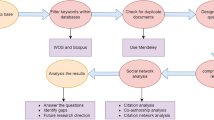Abstract
We study a sequential form of the distributed dual averaging algorithm that minimizes the sum of convex functions in a special case where the number of functions increases gradually. This is done by introducing an intermediate ‘pivot’ stage posed as a convex feasibility problem that minimizes average constraint violation with respect to a family of convex sets. Under this approach, we introduce a version of the minimum sum optimization problem that incorporates an evolving design space. Proof of mathematical convergence of the algorithm is complemented by an application problem that involves finding the location of a noisy, mobile source using an evolving wireless sensor network. Results obtained confirm that the new designs in the evolved design space are superior to the ones found in the original design space due to the unique path followed to reach the optimum.






Similar content being viewed by others
Notes
\(\Vert \cdot \Vert _*\) is the dual norm to \(\Vert \cdot \Vert \). See [6] for details.
With \(\text {int}(S)\) as the interior of the closed convex set S.
Symmetric difference \(\triangle V_t = V_t \triangle V_{t+} = (V_t \cup V_{t+}) \setminus (V_t \cap V_{t+}) \).
References
Bertsekas, D.P.: Incremental gradient, subgradient, and proximal methods for convex optimization: a survey. Optim. Mach. Learn. 2010, 1–38 (2011)
Bertsekas, D.P.: Incremental proximal methods for large scale convex optimization. Math. Program. 129(2), 163–195 (2011)
Nedic, A.: Random projection algorithms for convex set intersection problems. In: 2010 49th IEEE Conference on Decision and Control (CDC), pp. 7655–7660. IEEE (2010)
Nedic, A., Ozdaglar, A.: Distributed subgradient methods for multi-agent optimization. IEEE Trans. Autom. Control 54(1), 48–61 (2009)
Rabbat, M.G., Nowak, R.D.: Quantized incremental algorithms for distributed optimization. IEEE J. Sel. Areas Commun. 23(4), 798–808 (2005)
Duchi, J.C., Agarwal, A., Wainwright, M.J.: Dual averaging for distributed optimization: convergence analysis and network scaling. IEEE Trans. Autom. Control 57(3), 592–606 (2012)
Johansson, B., Rabi, M., Johansson, M.: A randomized incremental subgradient method for distributed optimization in networked systems. SIAM J. Optim. 20(3), 1157–1170 (2009)
Ram, S.S., Nedić, A., Veeravalli, V.V.: Distributed stochastic subgradient projection algorithms for convex optimization. J. Optim. Theory Appl. 147(3), 516–545 (2010)
Censor, Y., De Pierro, A.R., Zaknoon, M.: Steered sequential projections for the inconsistent convex feasibility problem. Nonlinear Anal. Theory Methods Appl. 59(3), 385–405 (2004)
De Pierro, A.R., Iusem, A.: A relaxed version of Bregman’s method for convex programming. J. Optim. Theory Appl. 51(3), 421–440 (1986)
Censor, Y., Lent, A.: An iterative row-action method for interval convex programming. J. Optim. Theory Appl. 34(3), 321–353 (1981)
Censor, Y., Motova, A., Segal, A.: Perturbed projections and subgradient projections for the multiple-sets split feasibility problem. J. Math. Anal. Appl. 327(2), 1244–1256 (2007)
Byrne, C.: Bregman-Legendre multidistance projection algorithms for convex feasibility and optimization. Stud. Comput. Math. 8, 87–99 (2001)
Aharoni, R., Berman, A., Censor, Y.: An interior points algorithm for the convex feasibility problem. Adv. Appl. Math. 4(4), 479–489 (1983)
Chinneck, J.W.: Feasibility and Infeasibility in Optimization: Algorithms and Computational Methods, vol. 118. Springer, Berlin (2007)
Amaldi, E., Pfetsch Jr., M.E., Trotter L.E.: Some structural and algorithmic properties of the maximum feasible subsystem problem. In: Integer Programming and Combinatorial Optimization, pp. 45–59. Springer (1999)
Pfetsch, M.E.: Branch-and-Cut for the Maximum Feasible Subsystem Problem. Konrad-Zuse-Zentrum fr Informationstechnik, Berlin (2005)
Karger, D.R.: Global min-cuts in rnc, and other ramifications of a simple min-cut algorithm. In: Proceedings of 4th Annual ACM-SIAM Symposium on Discrete Algorithms, vol. 93 (1993)
Bauschke, H.H., Borwein, J.M.: On projection algorithms for solving convex feasibility problems. SIAM Rev. 38(3), 367–426 (1996)
Wang, M., Bertsekas, D.P.: Incremental constraint projection-proximal methods for nonsmooth convex optimization. Technical report, MIT (2013)
Deutsch, F., Hundal, H.: The rate of convergence for the cyclic projections algorithm III: regularity of convex sets. J. Approx. Theory 155(2), 155–184 (2008)
Hero, A.O., Cochran, D.: Sensor management: past, present, and future. Sens. J., IEEE 11(12), 3064–3075 (2011)
Cattivelli, F.S., Lopes, C.G., Sayed, A.H.: Diffusion recursive least-squares for distributed estimation over adaptive networks. IEEE Trans. Signal Process. 56(5), 1865–1877 (2008)
Kekatos, V., Giannakis, G.B.: Distributed robust power system state estimation. IEEE Trans. Power Syst. 28(2), 1617–1626 (2013)
Rabbat, M., Nowak, R.: Distributed optimization in sensor networks. In: Proceedings of the 3rd International Symposium on Information Processing in Sensor Networks, pp. 20–27. ACM (2004)
Huber, P.J., et al.: Robust estimation of a location parameter. Ann. Math. Stat. 35(1), 73–101 (1964)
Léger, J.B., Kieffer, M.: Guaranteed robust distributed estimation in a network of sensors. In: 2010 IEEE International Conference on Acoustics Speech and Signal Processing (ICASSP), pp. 3378–3381. IEEE (2010)
Delouille, V., Neelamani, R., Baraniuk, R.: Robust distributed estimation in sensor networks using the embedded polygons algorithm. In: Proceedings of the 3rd International Symposium on Information processing in Sensor Networks, pp. 405–413. ACM (2004)
Moore, D., Leonard, J., Rus, D., Teller, S.: Robust distributed network localization with noisy range measurements. In: Proceedings of the 2nd International Conference on Embedded Networked Sensor Systems, pp. 50–61. ACM (2004)
Li, Q., Wong, W.: Optimal estimator for distributed anonymous observers. J. Optim. Theory Appl. 140(1), 55–75 (2009)
Xiao, L., Boyd, S., Lall, S.: A scheme for robust distributed sensor fusion based on average consensus. In: Fourth International Symposium on Information Processing in Sensor Networks, 2005. IPSN 2005, pp. 63–70. IEEE (2005)
Author information
Authors and Affiliations
Corresponding author
Rights and permissions
About this article
Cite this article
Subramanian, S.V., DeLaurentis, D.A. & Sun, D. Dual Averaging with Adaptive Random Projection for Solving Evolving Distributed Optimization Problems. J Optim Theory Appl 170, 493–511 (2016). https://doi.org/10.1007/s10957-016-0932-z
Received:
Accepted:
Published:
Issue Date:
DOI: https://doi.org/10.1007/s10957-016-0932-z
Keywords
- Convex optimization
- Dual averaging
- Maximum feasibility problem
- Distributed
- Sensor management
- Topology optimization




